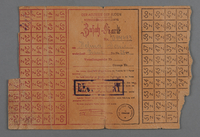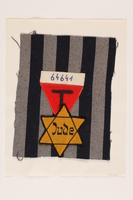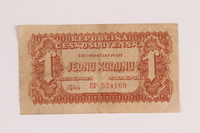Overview
- Brief Narrative
- Łódź Ghetto scrip, 5 [funf] mark note, acquired by Beno Helmer who was imprisoned in the Ghetto from 1941 - spring 1944. Ghetto inmates were not allowed to have currency. Scrip was issued as a labor incentive and facilitated the confiscation of money and goods from internees. There was little to exchange it for in the ghetto. In 1941, Beno, 18, and his family were interned in Łódź Ghetto, set up by the Germans after their occupation of Poland in September 1939. In spring 1944, as the ghetto was liquidated, Beno and his family were sent to Auschwitz concentration camp. Beno was selected for labor and sent to a subcamp of Gross-Rosen that supplied slave labor to the metalworks factory, Krupp Bertha-Werk, at Laskowitz-Meleschwitz. He was later transferred to Buchenwald, then Ludwigslust, a Neuengamme subcamp. Beno joined a Polish forced labor group that was conscripted into the Soviet Army. He was liberated by American soldiers while in a Soviet prisoner-of-war camp. The war ended in early May 1945 when Germany surrendered. All of Beno's family was killed, except one sister.
- Date
-
issue:
1940 May 15
- Geography
-
issue:
Litzmannstadt-Getto (Łódź, Poland);
Łódź (Poland)
- Credit Line
- United States Holocaust Memorial Museum Collection, Gift of Beno Helmer
- Markings
- face, upper right corner, printed, black ink : 5
face lower left corner, printed black and orange ink : 5
face, rectangle upper left corner, printed, black ink : Quittung / über [Receipt for]
face, center, printed, black and orange ink : Fünf Mark [Five Marks]
face, bottom, printed, black ink : Der Aelteste der Juden / in Litzmannstadt / M. Rumkowski / Litzmannstadt, den 15 Mai 1940 [Receipt for five marks / The Elder of the Jews in Litzmannstadt M. Rumkowski / Litzmannstadt, 15 May 1940]
reverse, upper left corner, printed black ink : Quittung über / Fünf Mark [Reciept for five marks]
reverse, bottom, printed, black ink : WER DIESE QUITTUNG VERFÄLSCHT ODER NACHMACHT ODER GEFÄLSCHTE / QUITTUNGEN IN VERKEHR BRINGT / WIRD STRENGSTENS BESTRAFT [Anyone who falsifies or copies this receipt, or traffics in counterfeit receipts, will be strictly punished]
reverse, lower right, printed, black and orange ink : 5 - Contributor
-
Subject:
Beno Helmer
Issuer: Der Aelteste der Juden in Litzmannstadt
- Biography
-
Beno Helmer was born in 1923 in Teplice-Sanov, Czechoslovakia, to Isaak and Dora Helmer. As a young man, Beno used his foreign language skills to land small movie roles. He and his family attempted to settle in Hungary. In 1939, because they did not have legal immigration papers, they were deported to Łódź, Poland. In February 1940, the German authorities set up a ghetto where Beno and his family and all Jewish residents were forced to move. In 1942, Beno had to perform forced labor outside the ghetto. Through an underground contact, he got a job under a false identity, posing as a non-Jewish German. He assisted the resistance by collecting information. He also helped commit acts of sabotage, and became an expert at derailing trains. Beno returned to the ghetto when his father became sick. He remained with his family until they were deported. In spring 1944, the Łódź ghetto was liquidated and the family was sent to Auschwitz concentration camp. Beno was separated from his family. He was sent to a series of German concentration camps, including a subcamp of Gross-Rosen associated with the metalworks factory, Krupp Bertha-Werk, at Laskowitz-Meleschwitz, then to Buchenwald, and to Ludwigslust, a subcamp of Neuengamme. He was liberated by American soldiers while in a Soviet prisoner-of-war camp. In an attempt to get back to Poland, he joined a Polish forced labor group that was later drafted into the Soviet Army. The war ended in early May 1945 when Germany surrendered. All of Beno's family was killed, except one sister, who he found after the war. He spent time hunting for Nazi war criminals. Beno remained in Europe for several years, but eventually immigrated to the United States
Physical Details
- Language
- German
- Classification
-
Exchange Media
- Category
-
Money
- Object Type
-
Scrip (aat)
- Physical Description
- Łódź ghetto scrip printed on rectangular offwhite paper in black and orange ink. The face has a latticework underprint. The serial number is in red in the upper left corner. The denomination 5 is in the lower left corner and in the upper right corner in an orange square. There is a 1.5 inch left margin, then a rectangle with a rounded upper left corner with a pattern of interlocked Stars of David and an encircled Star of David in the upper left corner. Across the center is the denomination Funf Mark and German text. The back has a blank 1.5 inch right margin and a rectangle with a pattern of interlocked Stars of David. In the upper left corner is the denomination Funf Mark and in the lower left corner is a menorah or 7-branched candelabrum. The denomination 5 is outside the lower right corner of the rectangle; above this, near the upper right corner, is a Star of David outline in a black square. The scrip is worn, creased, and has dark stains.
- Dimensions
- overall: Height: 2.750 inches (6.985 cm) | Width: 5.000 inches (12.7 cm)
- Materials
- overall : paper, ink
- Inscription
- face, upper left corner, stamped, red ink : No 586228
Rights & Restrictions
- Conditions on Access
- No restrictions on access
- Conditions on Use
- No restrictions on use
Keywords & Subjects
Administrative Notes
- Legal Status
- Permanent Collection
- Provenance
- The Theresienstadt scrip was donated to the United States Holocaust Memorial Museum in 1988 by Beno Helmer.
- Funding Note
- The cataloging of this artifact has been supported by a grant from the Conference on Jewish Material Claims Against Germany.
- Record last modified:
- 2022-07-28 18:21:07
- This page:
- https://collections.ushmm.org/search/catalog/irn786
Download & Licensing
In-Person Research
- By Appointment
- Request 21 Days in Advance of Visit
- Plan a Research Visit
- Request to See This Object
Contact Us
Also in Beno Helmer collection
The collection consists of a prisoner patch, currency, scrip and ration cards, and documents related to the experiences of Beno Helmer in the Łódź ghetto in Poland during the Holocaust.
Date: approximately 1940

Łódź Ghetto ration card issued to a ghetto inmate
Object
One of three ration cards saved by Beno Helmer, issued when he and his family were incarcerated in Łódź Ghetto in German occupied Poland from 1940- spring 1944. There are cards from three family members: Beno, Dora, and Sonia. Nazi Germany occupied Poland on September 1, 1939. Łódź was renamed Litzmannstadt and, in February 1940, the Germans forcibly relocated Beno, 18, and his family, along with the entire large Jewish population, into a sealed ghetto. All ghetto residents had to work in order to receive a ration card for food. There were severe food shortages and overcrowding and many died of starvation and disease. In spring 1944, as the ghetto was liquidated, Beno and his family were sent to Auschwitz concentration camp. Beno was selected for labor and sent to a subcamp of Gross-Rosen that supplied slave labor to the metalworks factory, Krupp Bertha-Werk, at Laskowitz-Meleschwitz. He was later transferred to Buchenwald, then Ludwigslust, a Neuengamme subcamp. Beno joined a Polish forced labor group that was conscripted into the Soviet Army. He was liberated by American soldiers while in a Soviet prisoner-of-war camp. The war ended in early May 1945 when Germany surrendered. All of Beno's family was killed, except for one sister.

Blue-gray striped uniform square with a red triangle and yellow Star of David badge
Object
Badge removed from a concentration camp uniform.

Republic of Czechoslovakia currency, 1 korunu note, acquired by a Jewish Polish survivor
Object
Czech currency, 1 korunu note, acquired by Beno Helmer under unknown circumstances. Ghetto inmates were not allowed to have currency. Scrip was issued as a labor incentive and facilitated the confiscation of money and goods from internees. There was little to exchange it for in the ghetto. In 1941, Beno, 18, and his family were interned in Łódź Ghetto, set up by the Germans after their occupation of Poland in September 1939. In spring 1944, as the ghetto was liquidated, Beno and his family were sent to Auschwitz concentration camp. Beno was selected for labor and sent to a subcamp of Gross-Rosen that supplied slave labor to the metalworks factory, Krupp Bertha-Werk, at Laskowitz-Meleschwitz. He was later transferred to Buchenwald, then Ludwigslust, a Neuengamme subcamp. Beno joined a Polish forced labor group that was conscripted into the Soviet Army. He was liberated by American soldiers while in a Soviet prisoner-of-war camp. The war ended in early May 1945 when Germany surrendered. All of Beno's family was killed, except one sister.

Theresienstadt ghetto-labor camp scrip, 5 kronen, acquired by Jewish Polish survivor
Object
Theresienstadt ghetto-labor camp scrip, valued at 5 [funf] kronen, acquired by Beno Helmer under unknown circumstances. Camp inmates were not allowed to have currency, which was confiscated. Scrip for use only in the camp was issued beginning May 1943 to promote an illusion of normalcy, as there was nothing to to exchange it for in the camp. In 1941, Beno, 18, and his family were interned in Łódź Ghetto, set up by the Germans after their occupation of Poland in September 1939. In spring 1944, as the ghetto was liquidated, Beno and his family were sent to Auschwitz concentration camp. Beno was selected for labor and sent to a subcamp of Gross-Rosen that supplied slave labor to the metalworks factory, Krupp Bertha-Werk, at Laskowitz-Meleschwitz. He was later transferred to Buchenwald, then Ludwigslust, a Neuengamme subcamp. Beno joined a Polish forced labor group that was conscripted into the Soviet Army. He was liberated by American soldiers while in a Soviet prisoner-of-war camp. The war ended in early May 1945 when Germany surrendered. All of Beno's family was killed, except one sister.
Łódź Ghetto ration card issued to a ghetto inmate
Object
One of three ration cards saved by Beno Helmer, issued when he and his family were incarcerated in Łódź Ghetto in German occupied Poland from 1940- spring 1944. There are cards from three family members: Beno, Dora, and Sonia. Nazi Germany occupied Poland on September 1, 1939. Łódź was renamed Litzmannstadt and, in February 1940, the Germans forcibly relocated Beno, 18, and his family, along with the entire large Jewish population, into a sealed ghetto. All ghetto residents had to work in order to receive a ration card for food. There were severe food shortages and overcrowding and many died of starvation and disease. In spring 1944, as the ghetto was liquidated, Beno and his family were sent to Auschwitz concentration camp. Beno was selected for labor and sent to a subcamp of Gross-Rosen that supplied slave labor to the metalworks factory, Krupp Bertha-Werk, at Laskowitz-Meleschwitz. He was later transferred to Buchenwald, then Ludwigslust, a Neuengamme subcamp. Beno joined a Polish forced labor group that was conscripted into the Soviet Army. He was liberated by American soldiers while in a Soviet prisoner-of-war camp. The war ended in early May 1945 when Germany surrendered. All of Beno's family was killed, except for one sister.
Łódź Ghetto ration card issued to a ghetto inmate
Object
One of three ration cards saved by Beno Helmer, issued when he and his family were incarcerated in Łódź Ghetto in German occupied Poland from 1940- spring 1944. There are cards from three family members: Beno, Dora, and Sonia. Nazi Germany occupied Poland on September 1, 1939. Łódź was renamed Litzmannstadt and, in February 1940, the Germans forcibly relocated Beno, 18, and his family, along with the entire large Jewish population, into a sealed ghetto. All ghetto residents had to work in order to receive a ration card for food. There were severe food shortages and overcrowding and many died of starvation and disease. In spring 1944, as the ghetto was liquidated, Beno and his family were sent to Auschwitz concentration camp. Beno was selected for labor and sent to a subcamp of Gross-Rosen that supplied slave labor to the metalworks factory, Krupp Bertha-Werk, at Laskowitz-Meleschwitz. He was later transferred to Buchenwald, then Ludwigslust, a Neuengamme subcamp. Beno joined a Polish forced labor group that was conscripted into the Soviet Army. He was liberated by American soldiers while in a Soviet prisoner-of-war camp. The war ended in early May 1945 when Germany surrendered. All of Beno's family was killed, except for one sister.
Postcard
Object
Ernie Pyle news report
Document
Single page typed transcript of a 1947 news report about the Ernie Pyle. Object removed from scrapbook accessioned as 1988.68.1.



